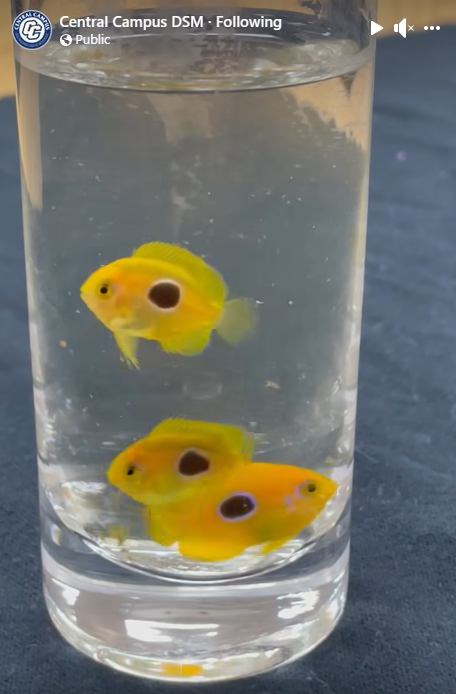
Big News from Central Campus Aquarium Science
Our students are thrilled to announce an incredible milestone: they have successfully spawned and raised the Lemonpeel Angelfish (Centropyge flavissima)!
Since 2010, Aquarium Science students have been honing their skills by breeding various clownfish species. But this accomplishment marks a first–raising a pelagically spawned marine species. Unlike clownfish, which lay their eggs in clusters on rocks, pelagic spawning happens in the water column, making it a real challenge to collect and hatch these nearly invisible eggs one by one.
It took almost 3 months of dedicated effort for students to nurture these tiny eggs into juvenile fish about half an inch in length. While the Lemonpeel Angelfish has been bred in aquariums before, it’s still not commonly available as aquacultured, making this achievement even more remarkable.
This year alone, our talented students have raised four new-to-the-program marine fish species, including the Neon Goby (Elacatinus oceanops), Lemon Damselfish (Pomacentrus moluccensis), and the Yellow Tailed Blue Damselfish (Chrysiptera parasema) [in addition to the Lemonpeel Angelfish].
Please join us in celebrating this incredible success. Watch the video to see the beautiful Lemonpeel Angelfish up close.
###
Editor’s Notes – Attendees at the 2011 MACNA in Des Moines, Iowa, had the wonderful opportunity to visit the Central Campus High School Marine Lab. At the time, it was already an impressive undertaking, and if you were there, you know how special this is.
The entire CORAL staff congratulates educator Kirk Embree and the entire team of dedicated Aquarium Sciences students for accomplishing a marine fish aquaculture success that is normally reserved for commercial-scale operation. The successful breeding of Centropyge spp. angelfish at home, by a single hobbyist, is almost never accomplished, being just too resource and time-intensive for a single individual.
We are all a bit envious that we didn’t get to have this experience ourselves as high school students, and can’t wait to see this next generation of aquarists continue to make meaningful contributions to science as they head out into the world!





Congratulations to Mr. Embree and the students! Well done!
Such a great achievement. Congratulations to everyone in the program.
Congratulations to Kirk and his students. Iowa should be proud.
Congratulations! Not many aquarists know the difficulties and have the dedication to achieve the culture of marine aquarium fish, in particular the angelfish. I spawned and reared clownfish and neon gobies in my garage 1971 and French and grey Angelish in a culture lab in the Keys in 1977. Pygmy angelfish eluded me however, I like to think it was because I didn’t have the time to work it out, but like most things, time and effort eventually solve problems. wins. I think, hope, the age where we can control the existence of marine fish both on land and in the sea will help solve the problems of human garbage destroying marine life. Mariculture still has a long way to go.
Martin,
We used to purchase your beautiful and healthy stock of “tank bred” French Angelfish in the 80’s. You pioneered the marine aquarium aquaculture industry!
I have maintained marine life in Pennsylvania (still much closer to the ocean that Iowa!) since 1970 (Hi, Martin Moe!) but never placed the time, resources, and energy into spawning and rearing.
I have also questioned the collection and keeping of these incredible creatures over that 50 year period even now, but with the manner in which we are impacting our reefs worldwide I cannot see a better way to lessen that impact then what you and so many others have accomplished.
So regards to all!
Congratulations!! In this age of “cell phones”, it’s refreshing to see hands on (reef aquaculture science) accomplishments like this. It takes a lot of skill and dedication.